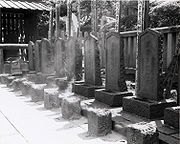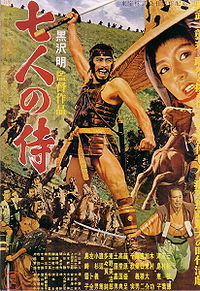Rōnin

A rōnin (浪人)[1] was a samurai with no lord or master during the feudal period (1185–1868) of Japan. A samurai became masterless from the death or fall of his master, or after the loss of his master's favor or privilege.
Contents |
Etymology
The word rōnin literally means "wave man". The term originated in the Nara and Heian periods, when it referred to a serf who had fled or deserted his master's land. It then came to be used for a samurai who had lost his master.
Status
According to the Bushido Shoshinshu (the Code of the Samurai), a samurai was supposed to commit oibara seppuku (also "hara kiri" – ritual suicide) upon the loss of his master. One who chose not to honor the code was "on his own" and was meant to suffer great shame. The undesirability of rōnin status was mainly a discrimination imposed by other samurai and by the daimyo (the feudal lords).
Like regular samurai, rōnin wore their two swords. Rōnin used a variety of other weapons too. Some rōnin, usually if they lacked money, would carry a bō (staff around 5 to 6 ft) or jō (smaller staff or walking stick around 3 to 5 ft) or they would use a yumi (bow). Most weapons would reflect the ryu or bujutsu school they came from if they were students.
During the Edo period, with the shogunate's rigid class system and laws, the number of rōnin greatly increased. Confiscation of fiefs during the rule of the third Tokugawa shogun Iemitsu resulted in an especially large increase of rōnin. During previous ages, samurai were easily able to move between masters and even between occupations. They would also marry between classes. However, during the Edo period, samurai were restricted, and were above all forbidden to become employed by another master without their previous master's permission. Also, low-level samurai, often poor and without choice, were forced to quit or escape their masters.
History

In the Kamakura and Muromachi periods, when warriors held lands that they occupied, a rōnin was a warrior who had lost his lands. During these periods, as small-scale wars frequently occurred throughout Japan, the daimyo needed to augment their armies, so rōnin had opportunities to serve new masters. Also, some rōnin joined in bands, engaging in robbery and uprisings.
Especially in the Sengoku period, daimyo needed additional fighting men, and even if one's master had perished, a rōnin was able to serve a new lord. In contrast to the later Edo period, the bond between the lord and the samurai was loose, and some samurai who were dissatisfied with their treatment left their masters and sought new lords. Many warriors served a succession of masters, and some even became daimyo. As an example, Tōdō Takatora served ten lords. Additionally, the division of the population into classes had not yet taken place, so it was possible to change one's occupation from warrior to merchant or farmer, or the reverse. Saitō Dōsan was one merchant who rose through the warrior ranks to become a daimyo.
As Toyotomi Hideyoshi unified progressively larger parts of the country, daimyo found it unnecessary to recruit new soldiers. Next, the Battle of Sekigahara (AD 1600) resulted in the confiscation or reduction of the fiefs of large numbers of daimyo on the losing side; in consequence, many samurai became rōnin. As many as a hundred thousand rōnin joined forces with Toyotomi Hideyori and fought at the Siege of Osaka. In the ensuing years of peace, there was less need to maintain expensive standing armies, and many surviving rōnin turned to farming or became townspeople. A few, such as Yamada Nagamasa, sought adventure overseas as mercenaries. Still, the majority lived in poverty as rōnin. Under the third Tokugawa shogun Iemitsu, their number approached half a million.
Initially, the shogunate viewed them as dangerous, and banished them from the cities or restricted the quarters where they could live. They also prohibited serving new masters. As rōnin found themselves with fewer and fewer options, they joined in the Keian Uprising (AD 1651). This forced the shogunate to rethink its policy. It relaxed restrictions on daimyo inheritance, resulting in fewer confiscations of fiefs; and it permitted rōnin to join new masters.
Among the most famous rōnin are Miyamoto Musashi, the famed swordsman, and the Forty-seven Rōnin.
Not having the status or power of employed samurai, rōnin were often disreputable, and the group was a target of humiliation or satire. It was undesirable to be a rōnin, as it meant being without a stipend.
As an indication of the humiliation felt by samurai who became rōnin, Lord Redesdale recorded that a rōnin killed himself at the graves of the Forty-Seven Rōnin. He left a note saying that he had tried to enter the service of the daimyo of the Chōshū Domain, but was refused. Wanting to serve no other master, and hating being a rōnin, he had decided to kill himself.
On the other hand, the famous 18th century writer Kyokutei Bakin renounced his allegiance to Matsudaira Nobunari, in whose service Bakin's samurai father had spent his life. Bakin became voluntarily a rōnin, and eventually spent his time writing books (many of them about samurai).
Portrayals in media

Thousands of modern works of Japanese fiction set in the Edo period cast characters who are rōnin. They are often portrayed as yōjimbo (bodyguards) or as watari-kashi (mercenary fighters). Another stereotypical occupation for fictional rōnin is the umbrella-maker.
The character Miyamoto Usagi, himself based on famed swordsman Miyamoto Musashi is the lead character in the comic book Usagi Yojimbo, a term literally translating to "Rabbit Bodyguard". True to the name, Usagi often takes work as a bodyguard, and works for various lords, most notably Lord Noriyuki, and teams with other Samurai, bounty hunters, and the like.
Jorge Luis Borges wrote a short story about the Forty-seven Rōnin.
The Rōnin are also a street gang in the video game Saints Row 2.
Ronins can be hired to supplement your daimyo's armies in the Shogun board game.
In Western fiction, Ronins are generally comparable to Western cowboys.
The film Ronin stars Robert De Niro as a former CIA operative who joins a terrorist group attempting to steal an unknown object for a splinter group of the IRA in Western Europe.
"Ronin" is a character portrayed in Marvel comics. The identity was first adopted by Maya Lopez, formerly Echo. After Maya was defeated by the Hand, Ronin became the second identity of Clint Barton, formerly "Hawkeye."
MMA fighter Carlos Newton's nickname is The Ronin.
In Age of Empires III you can hire ronin from a saloon, if you get the right upgrade.
You see Takanobu as a ronin the The Sign of the Chrysanthemum, he uses Muna (the main character) as a tool and tries to get him (Muna) to steal a high-grade sword from a sword master. Muna does this because he thinks that Takanobu is his father.
"Rōnin" as metaphor
The term rōnin is also used in modern Japan for students who failed the entrance examination for the high school or university of their choice, and then decide to spend the next year studying to retake the exam.[2]
References
- ↑ "rōnin, Japanese warrior". Encyclopædia Britannica. http://www.britannica.com/EBchecked/topic/509133/ronin. Retrieved 2009-08-29.
- ↑ Akihiko Yonekawa. Beyond Polite Japanese. page 25. Kodansha 2001. ISBN 4-7700-2773-7
See also
- Black knight
- Forty-seven rōnin
- Gonin Gumi—groups of households that united for collective protection against rōnin
- Hiraga Gennai—who wrote under the pen-name Tenjiku Rōnin
- Ronin (DC Comics)
- Yojimbo